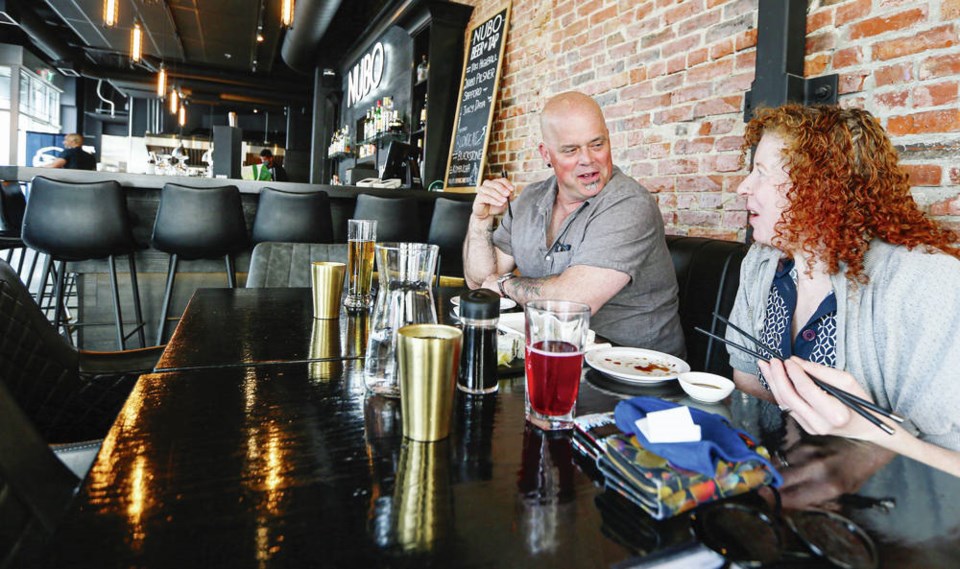“You’re not going to work dressed like that, are you?”
Jeez, there’s a line you haven’t heard for awhile.
“No,” you replied. “These are merely my car-warming clothes. Remind me again of what it was I wanted to wear.”
Well, not pyjama pants, for a start, not if you’re one of those people finally tiptoeing back into the office today. Actually, you might want to lose the whole Tom-Hanks-in-Cast-Away look, the Billy Connolly hair, shredded shorts and ’94 Commonwealth Games T-shirt that looks like it was used to clean a chainsaw. But you have to keep a mask on, at least until, what, July 1?
Yes, Canada Day is what it says on the chart, the handy-dandy grid that Dr. Bonnie and friends unveiled when laying out B.C.’s four-phase Restart 2.0 plan.
The grid is a welcome, useful tool, detailing what is permissible on each step of the path toward something resembling normalcy this fall. As of this week, you may not only dine inside restaurants, but may do so (in groups of six or fewer) with people who don’t live under your roof. You may have up to five visitors in your house, and up to 10 outside on your deck or lawn. Organized events may have up to 10 people inside and 50 outdoors.
If all goes well — vaccinations up, COVID counts down — we’ll see further, incremental easing of restrictions June 15, July 1 and Sept. 7. Small fairs and festivals, then larger events as the summer goes on. B.C.-wide travel, then Canada-wide travel. Ultimately, “normal social contact.” It’s all detailed on the grid.
Of course, human nature means some people will look at all those step-by-step measures, interpret them to mean the future is now, and throw a rager this weekend. Some will not only leap straight to stage four, which isn’t supposed to kick in until after Labour Day, but proceed to the mythical stage five, the one where they throw a massive, sweaty Twister party, everyone ripping off masks, plunging unwashed hands into a communal bowl of nachos, and passing around a bottle of lemon gin, taking turns drinking straight from the neck.
That’s the danger of being shown the road to victory: the temptation is to act as though the war is already over. It’s not. We’re at D-Day, not VE Day. Get your shots, wash those hands, stow the Twister.
With a map now in front of us, there is both giddiness and anxiety. After a year and a half, untangling ourselves from our COVID lives won’t be easy. There are questions that don’t fit neatly into a 24-square grid: How long must stores keep the Plexiglas up, and will they retain it anyway just to soothe nervous customers? Will grocery cashiers have to keep wiping down the check-out conveyor belt as though they’re going to perform surgery on it? When may/must you stop working from home? Will your boss order you back to your desk? When can you resume illicit liaisons in the office supply closet? (Ontario reported that cases of chlamydia and gonorrhea plummeted during the first months of the pandemic, but have since climbed back. It’s nice to see signs of recovery.)
At the Greater Victoria Chamber of Commerce, CEO Bruce Williams, who praises the restart plan, hears both happiness and anxiety from members. The most common question: “What is the new normal going to be?” His advice: take charge and find your own place. Figure out which parts of your old and current realities will still fit in the future. “There’s no need to repeat problems from the past.”
Challenges loom, though. Restaurants that relied on downtown office workers to fill their tables at lunch want to know when and if they’ll come back. Businesses that laid off experienced workers might find they have moved on and are hard to replace. Williams pointed out another factor: immigration, usually a big source of skilled labour, dried up during the pandemic.
Some sectors have been hit particularly hard. Williams says it would help if non-profit groups — a good-sized employer in this town — were eligible for the province’s $345 million pandemic assistance program for small- and medium businesses. And, with the full recovery plan coming too late for the summer tourism season, the chamber also wants federal rent and wage supplements for the hospitality industry extended until April.
The big picture, though, is promising. We are emerging from hibernation. Time to start anew. Optimism reigns. Don’t blow it.
jknox@timescolonist.com



